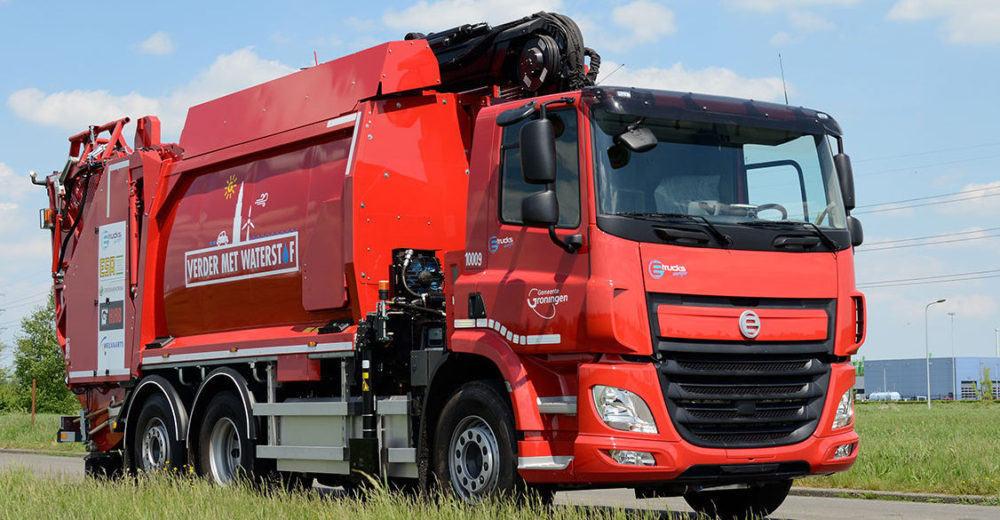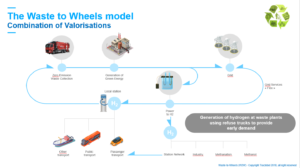
Raise the profile of the technology as a viable option for waste collection
+
Provide clear evidence that viable zero emissions solutions will exist for all vehicle types in the medium term
REVIVE stands for ‘Refuse Vehicle Innovation and Validation in Europe’. The project will run from the beginning of 2018 until June 2024.
REVIVE will significantly advance the state of development of fuel cell refuse trucks, by integrating fuel cell powertrains into 11 vehicles and deploying them across 6 sites in Europe. It will deliver substantial technical progress by integrating fuel cell systems from three suppliers into a mainstream DAF chassis, and developing effective hardware and control strategies to meet highly demanding refuse truck duty cycles. Specific work on standardisation will ensure that the lessons learned are applicable to the full range of OEMs supplying vehicles into the European market, helping to accelerate the introduction of next generation products.
In parallel, an extensive monitoring and analysis task will ensure the data on the vehicles is captured and that the economics of the trucks both today and into the future is assessed.
An additional task will explore the potential for ‘Waste-to-Wheel’ business models where the fuel cell trucks are combined with cheap(er) green hydrogen sourced from waste plants.
The Waste-to-Wheels model is a solution for a zero-emission mobility and is about having a circular solution to transform waste into renewable fuel. When organic waste is incinerated, the produced electricity can be converted into hydrogen. When powering refuse trucks with fuel cells, using green hydrogen sourced from waste, we close the circle. Any excess hydrogen can be used to power other fuel cells vehicles or to supply to other industrial applications. An important advantage is that the refuse trucks are operating in the proximity of the incinerator and thus there is no need for large investments in a national hydrogen refueling network to operate such captive fleets.

Waste-to-Wheels, a circular solution to convert waste into renewable fuel (downloadable image/ppt)
A successful demonstration of fuel cell trucks will have substantial impacts beyond the technical progress delivered by the project itself, as it will enable public authorities to continue implementing bold decarbonisation strategies by providing clear evidence that viable zero emissions solutions will exist for all vehicle types in the medium term. The project will also support the wider rollout of hydrogen mobility by introducing a further source of hydrogen demand that can improve the economics of existing and future refuelling station deployments, in turn facilitating the rollout of other vehicle types.
REVIVE’s overall objective is to be the largest demonstration of fuel cell-range extender trucks to date, one of very few options for the decarbonization of heavy duty vehicles. For urban trucks, there is an increasing need for zero emission solutions to comply with upcoming access restrictions imposed by cities as part of pollution reduction strategies.
The central, strategic objective of the REVIVE project is to accelerate the development of hydrogen fuelled refuse trucks in Europe to the point where they are considered a viable option for zero emission refuse collection. This will be achieved by the deployment of 11 fuel cell refuse vehicles in a number of European cities. These vehicles will be operated in real-world conditions by waste operators for at least two years. In parallel with the technical validation and demonstration work, the project aims to substantially increase the waste sector’s understanding of the benefits and business models for zero emission waste collection vehicles, thereby creating large amounts of customer demand to spur the introduction of next generation, mass-produced vehicles. This coupling of technical demonstration and demand creation will constitute a major step to bringing the technology forward to commercial deployments throughout Europe’s cities, both of zero emission refuse trucks and other truck types sharing the same platforms.
This project has received funding from the Fuel Cells and Hydrogen 2 Joint Undertaking (now Clean Hydrogen Partnership) under Grant Agreement No 779589. This Joint Undertaking receives support from the European Union’s Horizon 2020 Research and Innovation programme, Hydrogen Europe and Hydrogen Europe Research.